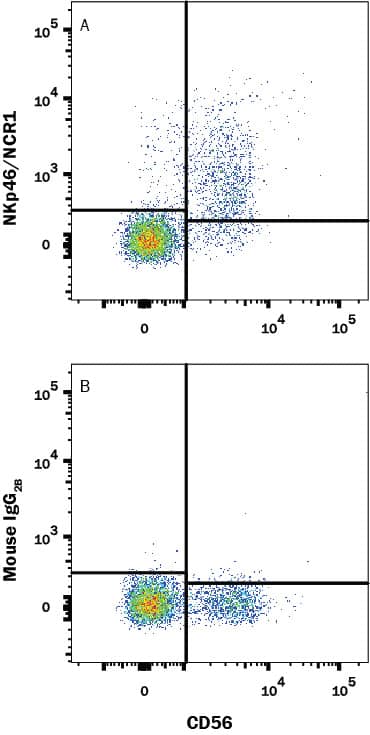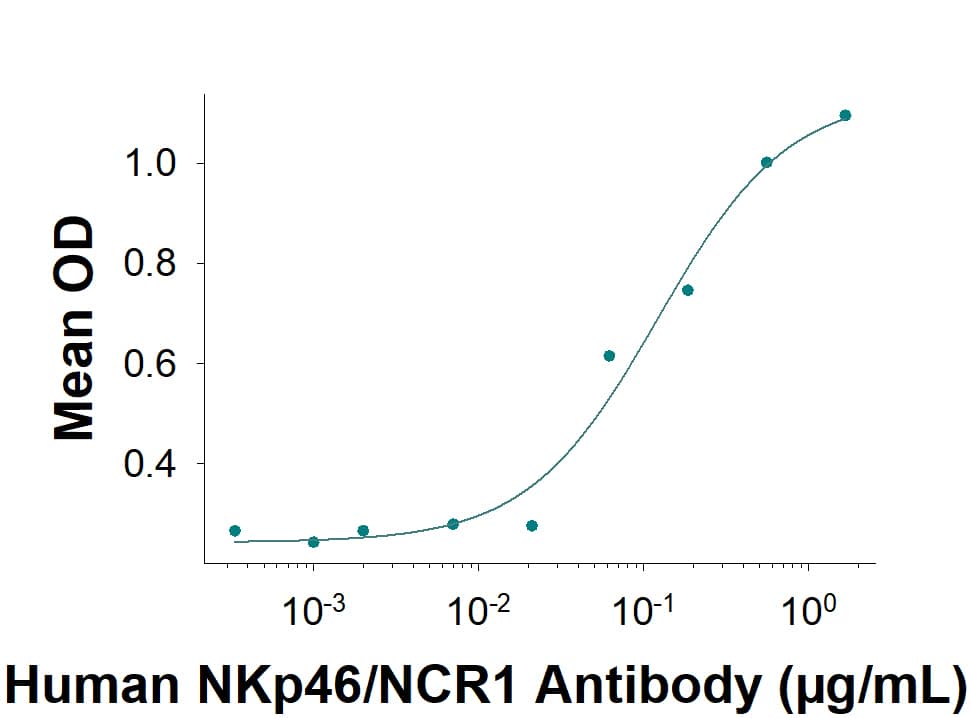Human NKp46/NCR1 Antibody Summary
Accession # O76036
Applications
Please Note: Optimal dilutions should be determined by each laboratory for each application. General Protocols are available in the Technical Information section on our website.
Scientific Data
 View Larger
View Larger
Detection of NKp46/NCR1 in Human PBMCs by Flow Cytometry. Human peripheral blood mononuclear cells (PBMCs) were stained with (A) Mouse Anti-Human NKp46/NCR1 Monoclonal Antibody (Catalog # MAB1850R) or (B) Mouse IgG2B Isotype Control (MAB0041) followed by Goat anti-Mouse IgG APC-conjugated Secondary Antibody (F0101B) and Rabbit Anti-Human NCAM-1/CD56 PE-conjugated Monoclonal Antibody (FAB24086P). Staining was performed using our Staining Membrane-associated Proteins protocol.
 View Larger
View Larger
Induce IFN-gamma secretion by Human NKp46/NCR1 antibody Measured by its ability to induce IFN-gamma secretion by NK-92 human natural killer lymphoma cells. The ED50 for this effect is 30.0 -300 ng/mL.
Preparation and Storage
- 12 months from date of receipt, -20 to -70 °C as supplied.
- 1 month, 2 to 8 °C under sterile conditions after reconstitution.
- 6 months, -20 to -70 °C under sterile conditions after reconstitution.
Background: NKp46/NCR1
NKp46, along with NKp30 and NKp44, are activating receptors that have been collectively termed the natural cytotoxicity receptors (NCR) (1). These receptors lack significant sequence homology to one another. They are expressed almost exclusively by NK cells and play a major role in triggering some of the key lytic activities of NK cells. The CD56dimCD16+ subpopulation that makes up the majority of NK cells in the peripheral blood and spleen expresses NKp46 in both resting and activated states (2). The main NK cell population of the lymph node (CD56brightCD16-) expresses low levels of NKp46 in resting cells, but expression is up-regulated by IL-2. NKp46 is a type I transmembrane protein with two extracellular Ig-like domains followed by a short stalk region, a transmembrane domain containing a positively charged amino acid residue, and a short cytoplasmic tail. Through its positive charge in the transmembrane domain, NKp46 associates with the ITAM‑bearing signal adapter proteins, CD3 zeta and Fc epsilon R1 gamma, which are able to form disulfide-linked homodimers and heterodimers (3, 8). Studies with neutralizing antibodies indicate that the three NCRs are primarily responsible for triggering the NK-mediated lysis of many human tumor cell lines. Blocking any of the NCRs individually resulted in partial inhibition of tumor cell lysis, but nearly complete inhibition of lysis was observed if all three receptors were blocked simultaneously (4). NKp46 has also been implicated in recognition of virus-infected cells through its capacity to bind to viral hemagglutinins (5‑7). Human NKp46 shares 58% and 59% amino acid sequence identity with the mouse and rat proteins, respectively.
- Moretta, L. and A. Moretta (2004) EMBO J. 23:255.
- Ferlazzo, G. et al. (2004) J. Immunol. 172:1455.
- Augugliaro, R. et al. (2003) Eur. J. Immunol. 33:1235.
- Pende, D. et al. (1999) J. Exp. Med. 190:1505.
- Arnon, T. et al. (2004) Blood 103:664.
- Arnon, T. et al. (2001) Eur. J. Immunol. 31:2680.
- Mandelboim, O. et al. (2001) Nature 409:1055.
- Moretta, A. et al. (2001) Annu. Rev. Immunol. 19:197.
Product Datasheets
FAQs
No product specific FAQs exist for this product, however you may
View all Antibody FAQsReviews for Human NKp46/NCR1 Antibody
There are currently no reviews for this product. Be the first to review Human NKp46/NCR1 Antibody and earn rewards!
Have you used Human NKp46/NCR1 Antibody?
Submit a review and receive an Amazon gift card.
$25/€18/£15/$25CAN/¥75 Yuan/¥2500 Yen for a review with an image
$10/€7/£6/$10 CAD/¥70 Yuan/¥1110 Yen for a review without an image


